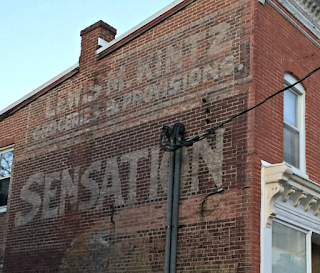Green Fireball Discussed at Pentagon
In late 1949, as the Cold War got increasingly tense, the Pentagon became interested in accounts of "green fireballs" over the Los Alamos lab in New Mexico and other military installations in the West. While meteors in the night sky can flash green*, they aren't terribly common, and these green fireballs were becoming so common and spooking so many personnel that the Air Force asked Dr. Joseph Kaplan of UCLA to look into them.
On 3 Nov. 1949, Kaplan reported his findings at a Pentagon meeting. Kaplan believed the green fireballs seen at Los Alamos represented a previously undetected type of "auroral display" -- though he conceded this explained neither "the rapid horizontal motion reported" nor "the occurrence of these phenomena at low magnetic altitudes" (qtd. in Gross 13).
Needless to say, Kaplan's explanation "did not escape criticism," in the words of UFO historian Loren E. Gross (60). In the ensuing animated discussion, one of the Pentagon scientists in attendance, Dr. Ross Gunn, told of his own sighting, in the Western Maryland skies.
DR. GUNN: Mr. Chairman, I would hate to upset
any claim of Arizona, Texas, or anything like this, but I have never heard of
these things before Dr. Kaplan brought it up. It is all new to me. But I saw what I
thought was a green meteorite** over Cumberland, Maryland, on August 20, I think
it was, about 11 o’clock. ... I checked with my pilot, and we were about 8,000
feet. He saw it, too. It reads along directly with this description as has been
given here. All that I can say is that it was a long ways from Texas. (qtd. in Gross 57)
At this, the director at Los Alamos, Dr. N.E. Bradbury, interjected: "We are very pleased," and there was laughter. Undeterred, Gunn continued.
DR. GUNN: The pilot saw it. He could be reached if there is any interest in it. I was interested enough to make a note of it in my notebook, but I thought it was a meteorite. It looked to me like a typical meteorite, more or less. It was green; that was the outstanding characteristic. It was green, and I looked it up in the encyclopedia to see what it said about green meteorites. I couldn’t find any reference to it, but it struck me as interesting. I can give you the exact details.
PROF. KAPLAN: This Canadian green fireball is one of
the first ones of its kind. … (qtd. in Gross 57)
Whereupon the conversation moved on, and no one questioned Gunn further about his Cumberland fireball. Having made up his mind, Kaplan clearly was uninterested in adding yet more sightings to his wrapped-up investigation. He was more concerned about ending the chatter among Los Alamos personnel: "The possibilities of rumor and panic that might develop [in] that area if loose talk about these green fireballs develops, I think, are great." (qtd. in Gross 51)
Certainly there has been no "loose talk" about this very interesting sighting over Cumberland, until now. To my knowledge, the meeting transcript was unseen until 2000, when Gross published it. In his attribution, Gross suggests a somewhat mysterious provenance for the transcript:
THE SCIENTIFIC ADVISORY BOARD TO THE CHIEF OF STAFF, UNITED STATES AIR FORCE. CONFERENCE. 3 November 1949. At the Pentagon, Washington, D.C. Classification: SECRET. Photocopy in author’s files. The original document was double spaced. It was retyped to fit more words on a page. The document is a rough draft. This accounts for the awkward language. Just where in government files this paperwork was located is not known to me. ... Document obtained by W.P. Laparl. (Gross 60)
I can find nothing (yet) about Laparl, but Gunn (1897-1966), was a prominent Pentagon physicist at the time, having worked on isotope separation for the Manhattan Project and done important theoretical work on nuclear-powered submarines. He was, in short, no kook. I wonder whether anyone followed up with him, after the meeting, about his Cumberland sighting.
Mainly I wonder whether anyone in Cumberland saw this 1949 green fireball from the ground.
*I've been lucky enough to see green fireballs twice myself: once in the Lexington, South Carolina, area in the 1980s, and once a few years ago, on an island off the coast of Maine.
**Gunn actually meant "meteor" rather than "meteorite," since he meant the flaming object in the atmosphere and not the crash-landed rock. In the void, a meteoroid; rockhound's delight, a meteorite; neither/nor, a meteor.
Sources:
Gross, Loren E. The Fifth Horseman of the Apocalypse: UFOs: A History. 1949 July-December Supplemental Notes. Fremont, Calif.: self-published, 2000.
"Ross Gunn." Wikipedia. https://en.wikipedia.org/wiki/Ross_Gunn. Accessed 30 Sept. 2021.

Comments
Post a Comment